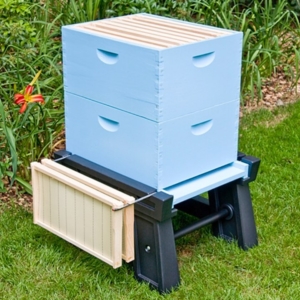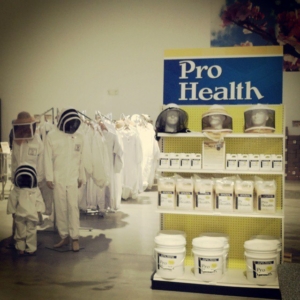March is a month where your bees can do great or they can do terrible. Yeah, that’s how to become a beekeeper – apiary is like a box of chocolates: you never know what you’re gonna get. bee population is expanding exponentially and the bees are consuming more food. Weather during March is a mix between winter and spring. Though the weather may be volatile, the bees are charging full speed ahead towards spring.
The queen is laying an enormous amount of eggs now. That brood requires a lot of honey and pollen to fully develop. The bees being laid now will hatch out into adult bees in 3 weeks. The increase in population can mean 2 things: the hive can starve before the main nectar flow starts or the bees feel crowded and decide to swarm.
This is the month where starvation is at it’s highest possibility. There isn’t a significant source of nectar naturally for bees at this point, so the only food available is any honey reserves left or sugar syrup is given to the bees.
When a significant amount of brood is being laid, which happens from mid-February through May, bees are on a constant search for water and pollen; both are required to raise healthy brood. You may see your bees sucking the moisture from potted plants or puddles, pulling trace minerals in the “dirty” water up as they suck up the water.
What once was only a 2 or 3 frames of brood in February, has quickly expanded into 8+ frames of brood. As cells of bees hatch out, they are quickly cleaned and prepared for a new egg to be laid in it. This is also the first time of the year when drones are being raised. Often, bees will form extra comb between frames to serve as a spot for the queen to lay drone eggs.
With all these new bees hatching out, you will see more activity in the front of the hive. You will see the most activity around 1 or 2 in the afternoon. This is when the new bees will take their orientation flights. Orientation flights are when the young bees fly outside the hive, visually mapping their surroundings.
This time of the year, varroa, wax moths and small hive beetle populations are low. But you should think about strategy beforehand. If you are planning hive fumigation – decide what device (oxalic acid vaporizer vs fogger) you will choose.
Temperature inside the bee hive
Thermal Camera Update
The red/yellow core on the box shows where the brood nest is. The center of the nest is located mostly in the top medium box and some of the 2nd box. Much of the heat from the bees collects directly above the cluster and is being dissipated across the inside cover.
A thermal camera video of a bee hive in early March with four medium 10-frame boxes. The concentrated red area towards the bottom third of the hive shows where the core of the nest is. This image was taken after the boxes were reversed and an addition medium box was added to the top. The red area under the telescoping cover shows where heat is rising and condensing under the inner cover.

What are beekeepers doing in March?
March is pretty much the last month to get ahead on equipment. Once the bees starting expanding and producing honey, their need for space and equipment increases quickly. Sometimes you need a box on your hive yesterday and finding a supplier quickly, can be difficult.
As your bees are expanding, many beekeepers will rotate boxes in hopes of stemming the bees desire to swarm. This is done by simply moving the bottom box to the top of the stack, preferably done just before a warm spell.
Many beekeepers will feed bees sugar syrup or pollen patties in the spring, but this isn’t necessary unless the bees are at risk of starving. It may be necessary if the beekeeper wants the bees to build in population very quickly. Be warned, though feeding bees syrup and pollen in the spring can cause them to swarm very quickly.
By using the bees natural instinct to grow and expand during the spring, a beekeeper can make splits or nucleus hives from their bees. This is the perfect time of the year to do this, as there will be a lot of drones in the air for queens to mate with. If you have never made a split, I would encourage you to try this year. It can be very easy to do, especially when using the walk away split method.
To further capitalize on the bees expanding, an optimistic beekeeper can set out swarm traps in the area to catch swarms. A swarm trap will not entice an established hive to leave their hive but will encourage a “homeless” swarm of bees to move into your trap. Lemongrass lure is a simple way to increase your odds of catching one.
If you have wanted to try your hand at pollen collection, this is a great time of the year to try.
March is a month where a strong hive can grow quickly and send out swarms. But March is also a month where weak hives can bite the dust. If the space between a lot of your frames looks congested, watch out for swarms. Early March is not too soon to put out swarm traps.
This is a great example of a swarm trap. March is a great time to put them out. Rules of thumb to follow:
- Use one, 5-frame deep frames or ten, medium frames for the trap
- Place the swarm trap 6-10′ off the ground
- Use a swarm lure, like swarm commander, used brood comb or lemongrass essential oil
- Be optimistic
Many beekeepers use pollen patties to help their bees. They often cause to build up their population very quickly. Which is helpful for some beekeepers, but can cause swarms beekeepers who are new. Use pollen patties very conservatively. More is not better with pollen patties.
If you are an established beekeeper, make a plan for what you want to do this year. Swarms and swarm cells are going to appear before you are ready. Are you going to let nature run it’s course or are you going to try and reduce your swarms this year? Either way, it’s good to have a plan. Swarm boxes are always a great idea, so get those up and out about 10′ off the ground so your bees can find them.
FEEDING YOUR BEES
One average medium frame full of honey will weigh 2.5 – 4 pounds. During March, bees will consume several pounds in a week, possibly causing starvation if they run out.
If you don’t believe your bees will have enough food to survive until the main nectar flow, it is important to feed them. Bees can be fed thin 1:1 syrup or thick 2:1 syrup this time of the year.
Pro tip: If you have several hives, it may be better to mix sugar syrup in a 5-gallon bucket. Attaching an inexpensive mortor/paint mixer to a drill will mix the sugar with the water very quickly.
You will find bees foraging for water in a lot of places. This bee was collecting water from the bed liner of our truck.
A queen bee will be physically large during the spring. This is a result of her increased egg laying. Queens will become slimmer during the winter and also when she is preparing to swarm.
What is coming up in beekeeping in April?
April is a big month for bees. It is often during April that the main nectar flow starts and many hives swarm. It is wise to plan ahead with the bees and provide them with what they need before they think they need it. Hope you and your beekeeping equipment are ready, cause it’s bee season.

